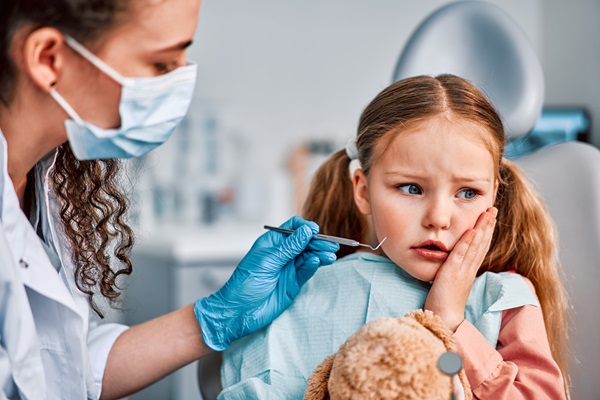Baby Bottle Rot: Causes, Prevention, and Treatment

Babies and toddlers may develop baby bottle rot, a dental problem caused by bacteria that thrive on the sugars found in milk and juice given to young children. It is a lot easier to prevent this issue than to treat it. However, if your child already has baby bottle tooth decay, you should take them to the dentist’s office for treatment.
Baby bottle rot is alternatively known as tooth decay of the teeth in infants and toddlers. This issue often affects the top front teeth because milk residue tends to accumulate there. By the age of three years, all of a child's baby teeth usually have come in. The thin enamel makes them susceptible to cavities and tooth decay.
The cause of baby bottle rot
Bottle rot is caused primarily by overfeeding children with sugary milk formulas or fruit juices in bottles. Other causes of bottle rot include:
- Regular bottle use: Utilizing a bottle regularly can result in tooth decay in babies as the sugar in the fluid remains in their mouths for long periods.
- Sugar exposure: The oral environment is altered by prolonged and frequent consumption of sugary beverages. Dental plaque and bacteria that cause cavities build up as a result of that.
- Poor oral hygiene: Tooth decay occurs frequently in babies and young children who lack a proper oral hygiene regimen.
Signs of baby bottle rot
Early childhood caries or baby bottle rot show as small cavities or discolored areas on the teeth. The child may experience symptoms like tooth pain, teeth sensitivity, and red, inflamed, or sensitive gums. In severe cases, patients may have bleeding gums, bad breath, and dark spots on the teeth.
Preventing baby bottle rot
Preventing bottle rot and maintaining healthy baby teeth during their childhood is important for overall dental health and cavity prevention. Parents should start good oral hygiene habits early in their child’s life to prevent tooth decay.
Practice good oral hygiene during pregnancy
Good oral hygiene habits are as basic as brushing twice daily, flossing, using fluoride-based products, and going for regular dental checkups. Women should add healthy eating habits to this routine as well. Untreated tooth decay in the mother triples the risk of the child developing cavities.
Practice good feeding habits
Good feeding habits can help prevent tooth decay in babies. Parents should try to transition from bottles to cups once the child is approaching the age of one. The consumption of sweet beverages like sodas and fruit juices should also be reduced significantly. It is advisable to feed the baby only breast milk, formula, or milk.
Another common cause of bottle rot is allowing infants to fall asleep while sucking on a bottle. Besides this, parents should minimize the liquid babies consume at night. Parents should stop using pacifiers by the age of four and avoid dipping them in sugary substances.
Clean the child’s oral cavity
Parents should clean their baby's gums twice a day with a washcloth before the first tooth appears. This helps maintain oral hygiene and prevents the buildup of harmful bacteria and decay. This oral hygiene routine will reduce the risk of tooth decay. It also helps the child cultivate good habits from the get-go.
Once their teeth erupt, the best oral hygiene practices to adopt include brushing the baby's teeth with a small toothbrush two times a day and using a small amount of fluoride toothpaste. Brushing should be supervised until about three years of age. Children should also floss regularly.
Finally, the child should be taken to the dentist biannually for dental cleanings and checkups. Professionals recommend starting once the child turns one year old or the first tooth comes in.
Baby bottle rot treatment
If a young child displays signs of bottle rot, they will probably need a dental procedure to repair the decayed tooth. A dentist may recommend different treatment options depending on the severity of the decay.
Fluoride treatments can strengthen the tooth enamel. The dentist will apply a fluoride solution or gel directly over the affected tooth or teeth. In case of decay, stainless steel crowns are a strong dental restoration that can protect the remaining teeth structure for a long time. If the decay is advanced, removing the entire tooth may be an option to prevent further issues.
Parents can get tooth sealants to protect their children's teeth after their baby teeth have fallen out. The dentist can apply sealants on healthy adult teeth that have no cavities. This layer protects newly emerged teeth from acid, food debris, and bacteria that cause cavities.
In conclusion
Baby bottle rot is a prevalent problem that can be prevented with proper oral hygiene practices. If you think your child has this dental issue, it is important to take them to the dentist immediately. Contact our pediatric dental office today for an appointment.
Request an appointment here: https://www.grandparkwaypediatricdental.com or call Grand Parkway Pediatric Dental at (832) 579-0960 for an appointment in our Richmond office.
Check out what others are saying about our services on Yelp: Baby Bottle Rot in Richmond, TX.
Recent Posts
Cavities can happen to anyone, but they are especially prevalent in children. However, composite fillings restore their primary and secondary teeth without sacrificing appearance. Composite resin, or tooth-colored fillings, allows children to receive the necessary repairs without using unattractive metals that parents may remember from their childhoods. Many pediatric dentists now use this approach for…
If your child has cavities caused by tooth decay, composite fillings can fill the hole, protect their teeth, and restore their smile. Many parents prefer this option for their kids because it has a more natural appearance and does not create an eyesore. Others prefer them because they do not contain the same ingredients as…
Pediatric dental patients with chipped or broken teeth have more options for tooth repair than in the past, such as composite fillings. These dental fillings can both restore a tooth and prevent the increased chance of gaps in the smile or shifting teeth that usually follows a tooth extraction. They can also provide a natural-looking…
A pediatric root canal can help preserve a child's oral health and prevent further complications when a tooth becomes damaged or infected. A dentist will determine if treatment is necessary based on symptoms and an examination. Understanding the signs of infection and the treatment process can help parents make the best decision for their child's…


